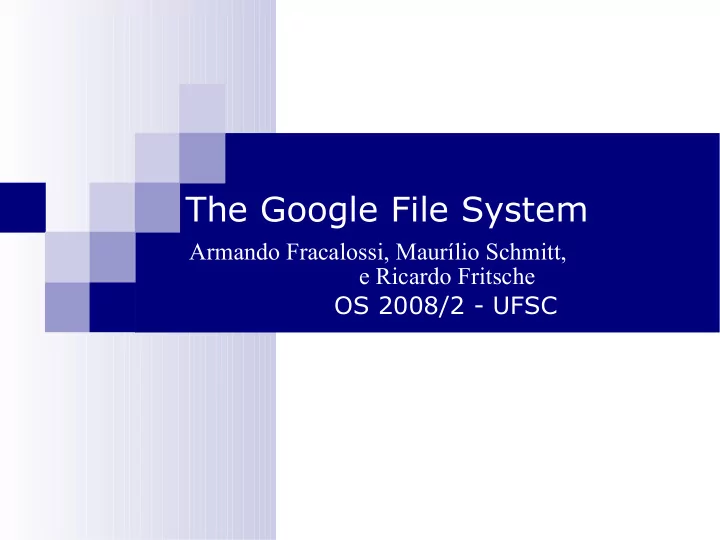

The Google File System Armando Fracalossi, Maurílio Schmitt, e Ricardo Fritsche OS 2008/2 - UFSC
Motivation Google needed a good distributed file system Redundant storage of massive amounts of data on cheap and unreliable computers Why not use an existing file system? Google’s problems are different from anyone else’s Different workload and design priorities GFS is designed for Google apps and workloads Google apps are designed for GFS
Assumptions High component failure rates Inexpensive commodity components fail all the time “Modest” number of HUGE files Just a few million Each is 100MB or larger; multi-GB files typical Files are write-once, mostly appended to Perhaps concurrently Large streaming reads High sustained throughput favored over low latency
GFS Design Decisions Files stored as chunks Fixed size (64MB) Reliability through replication Each chunk replicated across 3+ chunkservers Single master to coordinate access, keep metadata Simple centralized management No data caching Little benefit due to large data sets, streaming reads Familiar interface, but customize the API Simplify the problem; focus on Google apps Add snapshot and record append operations
GFS Architecture Single master Mutiple chunkservers …Can anyone see a potential weakness in this design?
Single master From distributed systems we know this is a: Single point of failure Scalability bottleneck GFS solutions: Shadow masters Minimize master involvement never move data through it, use only for metadata and cache metadata at clients large chunk size master delegates authority to primary replicas in data mutations (chunk leases) Simple, and good enough!
Metadata (1/2) Global metadata is stored on the master File and chunk namespaces Mapping from files to chunks Locations of each chunk’s replicas All in memory (64 bytes / chunk) Fast Easily accessible
Metadata (2/2) Master has an operation log for persistent logging of critical metadata updates persistent on local disk replicated checkpoints for faster recovery
Mutations Mutation = write or append must be done for all replicas Goal: minimize master involvement Lease mechanism: master picks one replica as primary; gives it a “lease” for mutations primary defines a serial order of mutations all replicas follow this order Data flow decoupled from control flow
Read Algorithm
Write Algorithm
Atomic record append Client specifies data GFS appends it to the file atomically at least once GFS picks the offset works for concurrent writers Used heavily by Google apps e.g., for files that serve as multiple-producer/single- consumer queues
Observations Clients can read in parallel. Clients can write in parallel. Clients can append records in parallel.
Relaxed consistency model (1/2) “Consistent” = all replicas have the same value “Defined” = replica reflects the mutation, consistent Some properties: concurrent writes leave region consistent, but possibly undefined failed writes leave the region inconsistent Some work has moved into the applications: e.g., self-validating, self-identifying records
Relaxed consistency model (2/2) Simple, efficient Google apps can live with it what about other apps? Namespace updates atomic and serializable
Master’s responsibilities (1/2) Metadata storage Namespace management/locking Periodic communication with chunkservers give instructions, collect state, track cluster health Chunk creation, re-replication, rebalancing balance space utilization and access speed spread replicas across racks to reduce correlated failures re-replicate data if redundancy falls below threshold rebalance data to smooth out storage and request load
Master’s responsibilities (2/2) Garbage Collection simpler, more reliable than traditional file delete master logs the deletion, renames the file to a hidden name lazily garbage collects hidden files Stale replica deletion detect “stale” replicas using chunk version numbers
Fault Tolerance High availability fast recovery master and chunkservers restartable in a few seconds chunk replication default: 3 replicas. shadow masters Data integrity checksum every 64KB block in each chunk
Performance
Deployment in Google Many GFS clusters hundreds/thousands of storage nodes each Managing petabytes of data GFS is under BigTable, etc.
Conclusion GFS demonstrates how to support large-scale processing workloads on commodity hardware design to tolerate frequent component failures optimize for huge files that are mostly appended and read feel free to relax and extend FS interface as required go for simple solutions (e.g., single master) GFS has met Google’s storage needs… it must be good!
Recommend
More recommend